Page 63 of 714
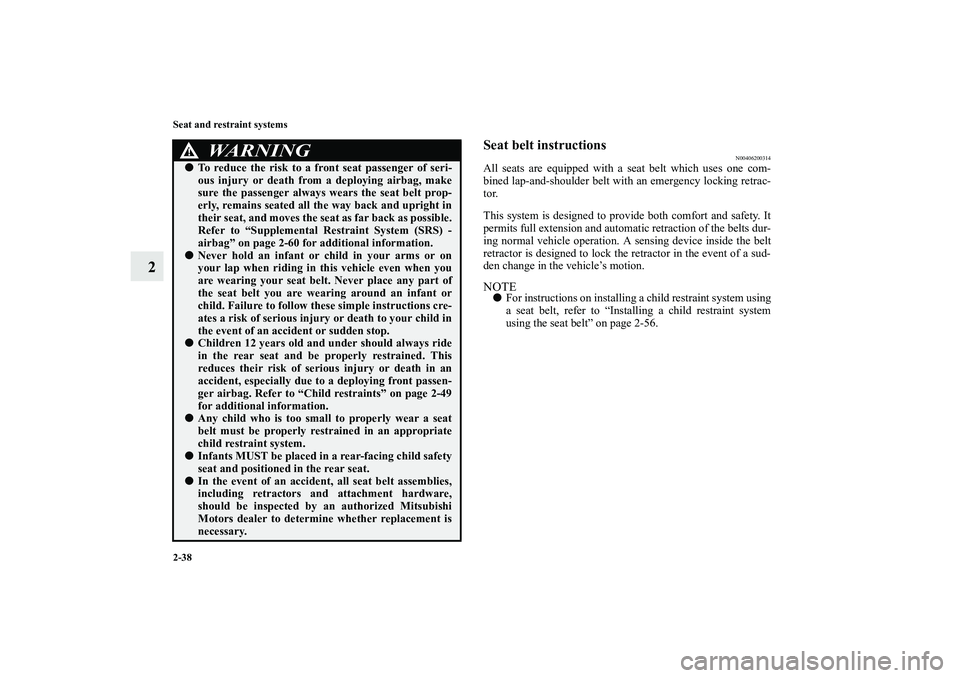
2-38 Seat and restraint systems
2
Seat belt instructions
N00406200314
All seats are equipped with a seat belt which uses one com-
bined lap-and-shoulder belt with an emergency locking retrac-
tor.
This system is designed to provide both comfort and safety. It
permits full extension and automatic retraction of the belts dur-
ing normal vehicle operation. A sensing device inside the belt
retractor is designed to lock the retractor in the event of a sud-
den change in the vehicle’s motion.NOTE�
For instructions on installing a child restraint system using
a seat belt, refer to “Installing a child restraint system
using the seat belt” on page 2-56.
�
To reduce the risk to a front seat passenger of seri-
ous injury or death from a deploying airbag, make
sure the passenger always wears the seat belt prop-
erly, remains seated all the way back and upright in
their seat, and moves the seat as far back as possible.
Refer to “Supplemental Restraint System (SRS) -
airbag” on page 2-60 for additional information.
�
Never hold an infant or child in your arms or on
your lap when riding in this vehicle even when you
are wearing your seat belt. Never place any part of
the seat belt you are wearing around an infant or
child. Failure to follow these simple instructions cre-
ates a risk of serious injury or death to your child in
the event of an accident or sudden stop.
�
Children 12 years old and under should always ride
in the rear seat and be properly restrained. This
reduces their risk of serious injury or death in an
accident, especially due to a deploying front passen-
ger airbag. Refer to “Child restraints” on page 2-49
for additional information.
�
Any child who is too small to properly wear a seat
belt must be properly restrained in an appropriate
child restraint system.
�
Infants MUST be placed in a rear-facing child safety
seat and positioned in the rear seat.
�
In the event of an accident, all seat belt assemblies,
including retractors and attachment hardware,
should be inspected by an authorized Mitsubishi
Motors dealer to determine whether replacement is
necessary.WA R N I N G
!
BK0115300US.book 38 ページ 2009年7月16日 木曜日 午前9時13分
Page 64 of 714
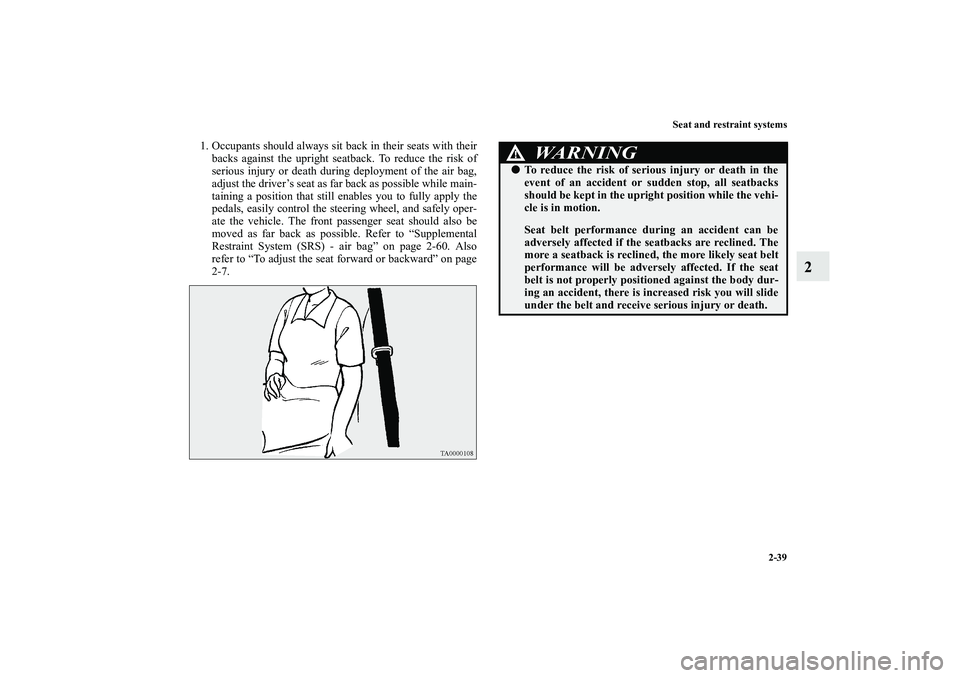
Seat and restraint systems
2-39
2
1. Occupants should always sit back in their seats with their
backs against the upright seatback. To reduce the risk of
serious injury or death during deployment of the air bag,
adjust the driver’s seat as far back as possible while main-
taining a position that still enables you to fully apply the
pedals, easily control the steering wheel, and safely oper-
ate the vehicle. The front passenger seat should also be
moved as far back as possible. Refer to “Supplemental
Restraint System (SRS) - air bag” on page 2-60. Also
refer to “To adjust the seat forward or backward” on page
2-7.
WA R N I N G
!�
To reduce the risk of serious injury or death in the
event of an accident or sudden stop, all seatbacks
should be kept in the upright position while the vehi-
cle is in motion.
Seat belt performance during an accident can be
adversely affected if the seatbacks are reclined. The
more a seatback is reclined, the more likely seat belt
performance will be adversely affected. If the seat
belt is not properly positioned against the body dur-
ing an accident, there is increased risk you will slide
under the belt and receive serious injury or death.
BK0115300US.book 39 ページ 2009年7月16日 木曜日 午前9時13分
Page 68 of 714
Seat and restraint systems
2-43
2
Front passenger seat belt warning light
N00418300181
The front passenger seat belt warning light is located in the
instrument panel.
When the key is turned to the “ON” position, this indicator nor-
mally comes on and goes off a few seconds later.
The light comes on when a person sits on the front passenger
seat but does not fasten the seat belt. It goes off when the seat
belt is subsequently fastened.
Adjustable seat belt shoulder anchor (front seats)
N00406300298
To move the anchor (A) down, press the lock knob (B) and
slide the anchor down to the desired position.
WA R N I N G
!�
Do not install any accessory or sticker that makes
the light difficult to see.
Anchor down Anchor up
BK0115300US.book 43 ページ 2009年7月16日 木曜日 午前9時13分
Page 71 of 714
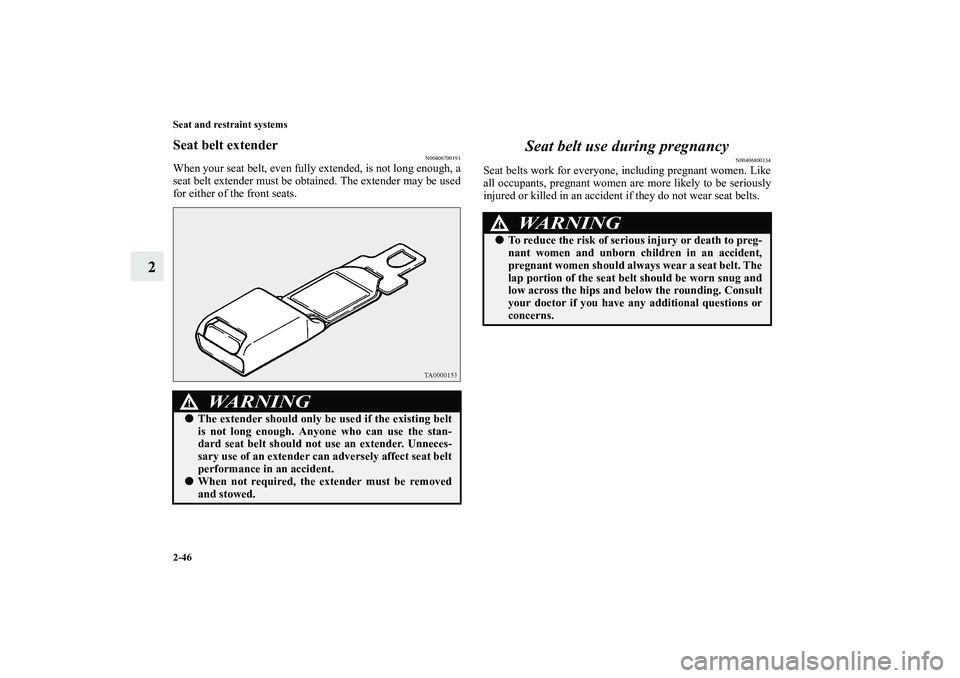
2-46 Seat and restraint systems
2
Seat belt extender
N00406700191
When your seat belt, even fully extended, is not long enough, a
seat belt extender must be obtained. The extender may be used
for either of the front seats.
Seat belt use during pregnancy
N00406800134
Seat belts work for everyone, including pregnant women. Like
all occupants, pregnant women are more likely to be seriously
injured or killed in an accident if they do not wear seat belts.
WA R N I N G
!�
The extender should only be used if the existing belt
is not long enough. Anyone who can use the stan-
dard seat belt should not use an extender. Unneces-
sary use of an extender can adversely affect seat belt
performance in an accident.
�
When not required, the extender must be removed
and stowed.
WA R N I N G
!�
To reduce the risk of serious injury or death to preg-
nant women and unborn children in an accident,
pregnant women should always wear a seat belt. The
lap portion of the seat belt should be worn snug and
low across the hips and below the rounding. Consult
your doctor if you have any additional questions or
concerns.
BK0115300US.book 46 ページ 2009年7月16日 木曜日 午前9時13分
Page 72 of 714
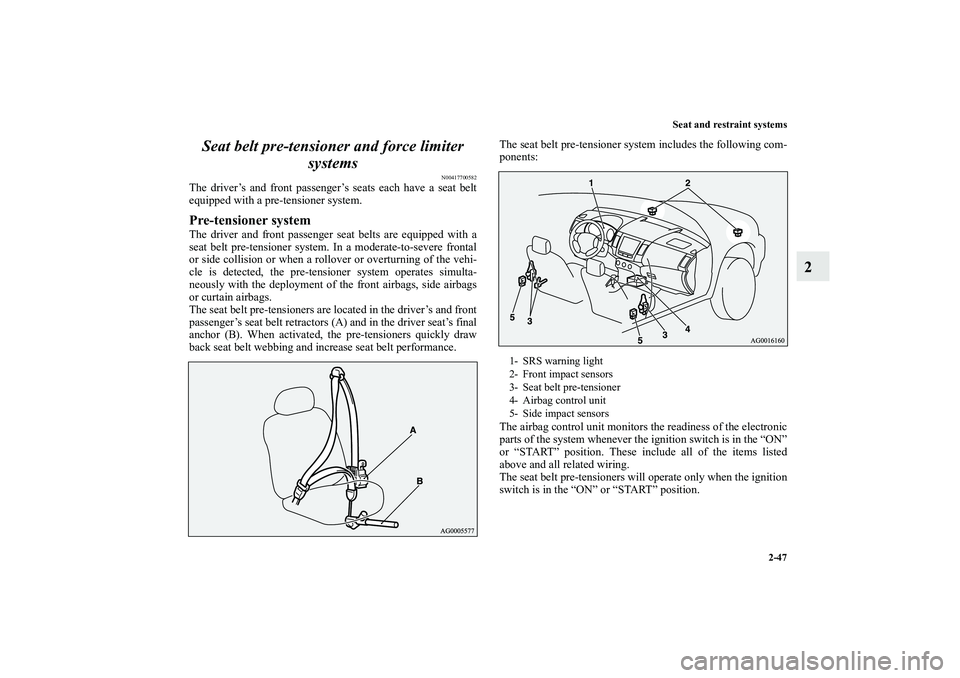
Seat and restraint systems
2-47
2 Seat belt pre-tensioner and force limiter
systems
N00417700582
The driver’s and front passenger’s seats each have a seat belt
equipped with a pre-tensioner system.Pre-tensioner systemThe driver and front passenger seat belts are equipped with a
seat belt pre-tensioner system. In a moderate-to-severe frontal
or side collision or when a rollover or overturning of the vehi-
cle is detected, the pre-tensioner system operates simulta-
neously with the deployment of the front airbags, side airbags
or curtain airbags.
The seat belt pre-tensioners are located in the driver’s and front
passenger’s seat belt retractors (A) and in the driver seat’s final
anchor (B). When activated, the pre-tensioners quickly draw
back seat belt webbing and increase seat belt performance.The seat belt pre-tensioner system includes the following com-
ponents:
The airbag control unit monitors the readiness of the electronic
parts of the system whenever the ignition switch is in the “ON”
or “START” position. These include all of the items listed
above and all related wiring.
The seat belt pre-tensioners will operate only when the ignition
switch is in the “ON” or “START” position.
1- SRS warning light
2- Front impact sensors
3- Seat belt pre-tensioner
4- Airbag control unit
5- Side impact sensors
BK0115300US.book 47 ページ 2009年7月16日 木曜日 午前9時13分
Page 78 of 714
Seat and restraint systems
2-53
2
Tether anchor locations
N00418900099
Your vehicle has 3 attachment points on the backside of the
second row seats. These are for securing a child restraint sys-
tem tether strap to each of the 3 rear seating positions in your
vehicle.
Examples of child restraint systems compatible with the
LATCH system
N00419000114
A- Rear-facing child restraint system
B- Front-facing child restraint system
C- Child restraint system lower anchor connectors
D- Tether strap
(These are only examples.)
BK0115300US.book 53 ページ 2009年7月16日 木曜日 午前9時13分
Page 79 of 714
2-54 Seat and restraint systems
2
Using the LATCH system
N00419100173
1. In order to securely fasten the tether strap, remove the
head restraint from the location where you wish to install
the child restraint system.2. Push the anchor connectors on the child restraint system
(A) into the slits (B) in accordance with the instructions
provided by the child restraint system manufacturer.
Remember, the lower anchors (E) provided with your
vehicle are designed to secure suitable child restraint sys-
tems compatible with the LATCH system in the outboard
positions of the second row seats only. The anchor con-
nectors are NOT designed to secure a suitable child
restraint system in the center position of the second row
seat.
A- Connector
B- Slit
C- Vehicle seatback
D- Vehicle seat cushion
E- Lower anchor
BK0115300US.book 54 ページ 2009年7月16日 木曜日 午前9時13分
Page 85 of 714
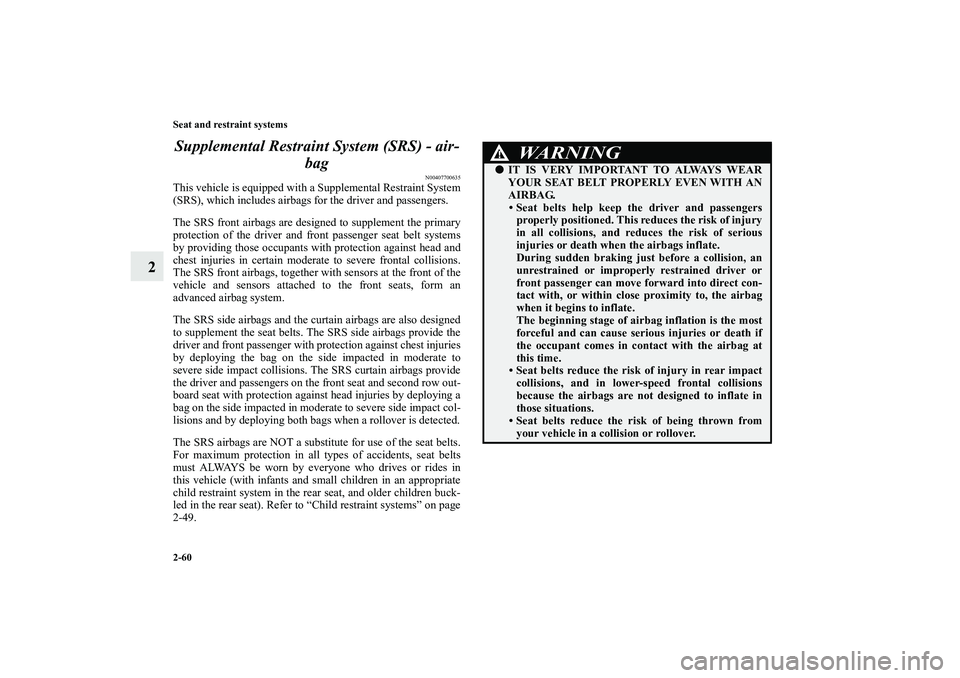
2-60 Seat and restraint systems
2Supplemental Restraint System (SRS) - air-
bag
N00407700635
This vehicle is equipped with a Supplemental Restraint System
(SRS), which includes airbags for the driver and passengers.
The SRS front airbags are designed to supplement the primary
protection of the driver and front passenger seat belt systems
by providing those occupants with protection against head and
chest injuries in certain moderate to severe frontal collisions.
The SRS front airbags, together with sensors at the front of the
vehicle and sensors attached to the front seats, form an
advanced airbag system.
The SRS side airbags and the curtain airbags are also designed
to supplement the seat belts. The SRS side airbags provide the
driver and front passenger with protection against chest injuries
by deploying the bag on the side impacted in moderate to
severe side impact collisions. The SRS curtain airbags provide
the driver and passengers on the front seat and second row out-
board seat with protection against head injuries by deploying a
bag on the side impacted in moderate to severe side impact col-
lisions and by deploying both bags when a rollover is detected.
The SRS airbags are NOT a substitute for use of the seat belts.
For maximum protection in all types of accidents, seat belts
must ALWAYS be worn by everyone who drives or rides in
this vehicle (with infants and small children in an appropriate
child restraint system in the rear seat, and older children buck-
led in the rear seat). Refer to “Child restraint systems” on page
2-49.
WA R N I N G
!�
IT IS VERY IMPORTANT TO ALWAYS WEAR
YOUR SEAT BELT PROPERLY EVEN WITH AN
AIRBAG. Seat belts help keep the driver and passengers
properly positioned. This reduces the risk of injury
in all collisions, and reduces the risk of serious
injuries or death when the airbags inflate.
During sudden braking just before a collision, an
unrestrained or improperly restrained driver or
front passenger can move forward into direct con-
tact with, or within close proximity to, the airbag
when it begins to inflate.
The beginning stage of airbag inflation is the most
forceful and can cause serious injuries or death if
the occupant comes in contact with the airbag at
this time.
Seat belts reduce the risk of injury in rear impact
collisions, and in lower-speed frontal collisions
because the airbags are not designed to inflate in
those situations.
Seat belts reduce the risk of being thrown from
your vehicle in a collision or rollover.
BK0115300US.book 60 ページ 2009年7月16日 木曜日 午前9時13分